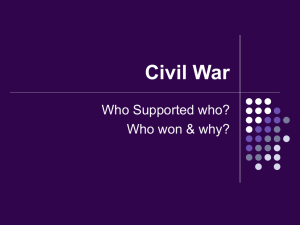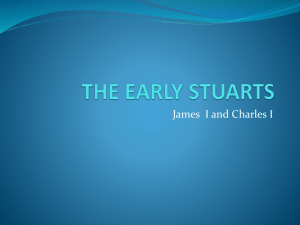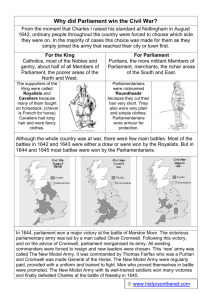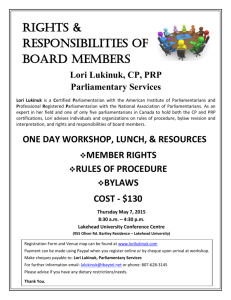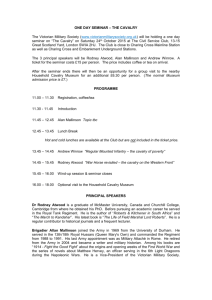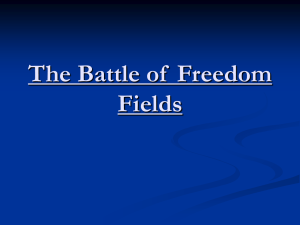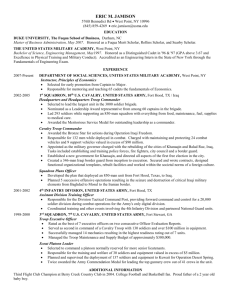English Civil War: The Main Battles
advertisement
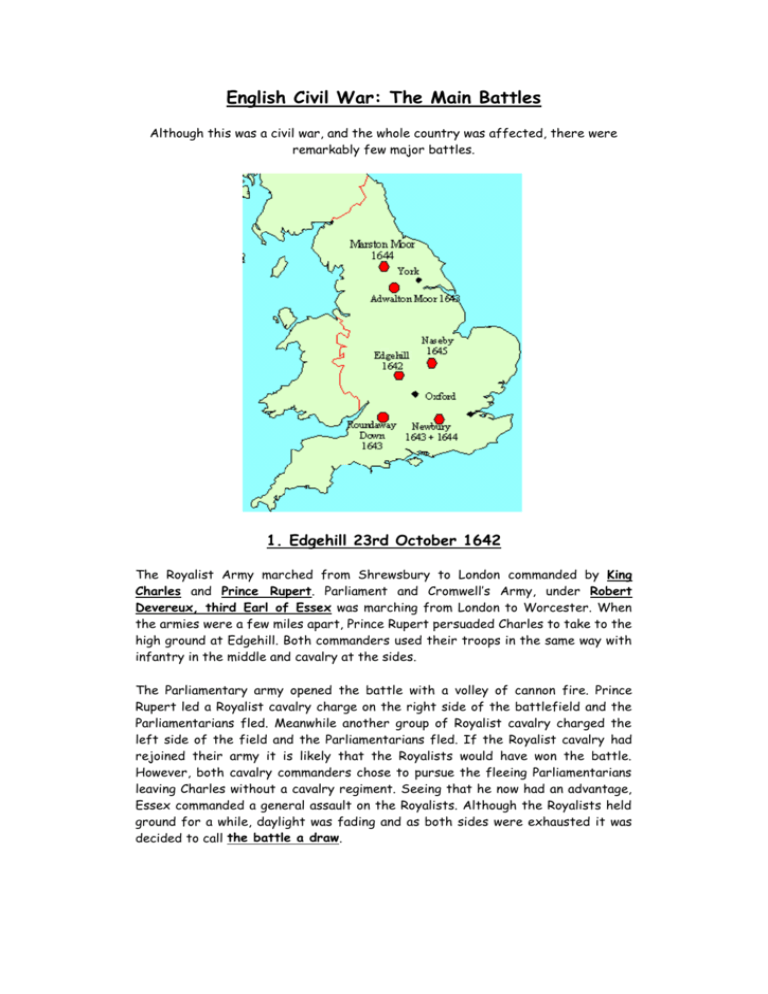
English Civil War: The Main Battles Although this was a civil war, and the whole country was affected, there were remarkably few major battles. 1. Edgehill 23rd October 1642 The Royalist Army marched from Shrewsbury to London commanded by King Charles and Prince Rupert. Parliament and Cromwell’s Army, under Robert Devereux, third Earl of Essex was marching from London to Worcester. When the armies were a few miles apart, Prince Rupert persuaded Charles to take to the high ground at Edgehill. Both commanders used their troops in the same way with infantry in the middle and cavalry at the sides. The Parliamentary army opened the battle with a volley of cannon fire. Prince Rupert led a Royalist cavalry charge on the right side of the battlefield and the Parliamentarians fled. Meanwhile another group of Royalist cavalry charged the left side of the field and the Parliamentarians fled. If the Royalist cavalry had rejoined their army it is likely that the Royalists would have won the battle. However, both cavalry commanders chose to pursue the fleeing Parliamentarians leaving Charles without a cavalry regiment. Seeing that he now had an advantage, Essex commanded a general assault on the Royalists. Although the Royalists held ground for a while, daylight was fading and as both sides were exhausted it was decided to call the battle a draw. 2. Adwalton Moor 30th June 1643 The Royalist commander, William Cavendish, Duke of Newcastle, decided to try and enclose the Parliamentarian army in Bradford. However, Fairfax, the Parliamentary commander decided that his army had a better chance if they went on the attack. The two armies met at Adwalton Moor, an area covered with fields enclosed by fences and hedges. This was not good country for the Royalist cavalry and Fairfax knew that this would give him an advantage even though his army was heavily outnumbered. Fairfax decided to adopt a defensive position and successfully withstood several Royalist charges. Feeling optimistic, several groups of Parliamentarian soldiers decided to pursue the Royalists rather than maintaining their defensive line. The Royalists were able to easily force the Parliamentarians to retreat to Bradford. Royalist victory! 3. Roundaway Down 13th July 1643 The Parliamentary commander Sir William Waller, had managed to push back the Royalist army, commanded by Lord Hopton, to Devizes. Lord Henry Wilmot was the Royalist commander who led a force to assist Hopton. When Waller realised that Hopton was approaching he took up battle position on Roundaway Down, just north of Devizes. He positioned his infantry in the middle and cavalry at the sides. The Royalists were the first to charge and for some reason there was no Parliamentarian counter-charge. After two more charges the Parliamentary cavalry had fled. Waller then turned his attention to the Parliamentary infantry. However, they stood firm until a force led by Hopton attacked them from behind. Caught between two Royalist armies the majority of Parliamentarian soldiers simply fled from the battlefield. Victory for the Royalists! 4. First Battle of Newbury 20th September 1643 Robert Devereux, third Earl of Essex, was attacked by a small company led by Prince Rupert, who wanted to slow his return to London. Rupert managed to slow the Parliamentarians enough to allow Charles I to reach the Parliamentarian town of Newbury before Essex. Charles positioned his army across Essex's route ensuring that the Parliamentarians would have no choice but to fight. The Royalists chose to attack Round Hill first. However, they were unable to mount a successful attack because the area was covered with hedgerows and bushes making it difficult for the cavalry to be effective. The Royalists suffered a number of losses and were driven back. A second Royalist attack on Round Hill was more successful and the Parliamentarians were pushed back. But the Royalist cavalry had been badly fired upon and no further attacks were made. The battle was declared a draw. 5. Marston Moor 2nd July 1644 Prince Rupert sent a message to William Cavendish, Duke of Newcastle, to meet him at Marston Moor. News of Rupert's position in the North reached Oliver Cromwell, the Parliamentary Lieutenant General, and an army was sent to meet the Royalists. The combined Royalist forces were outnumbered by the Parliamentarians but they decided to fight anyway. They reached their battle positions in the early evening and assumed that the battle would not begin until the early morning. Unfortunately for them the Parliamentarians had decided to mount an attack that evening and the Royalists were totally unprepared for the attack. For the first time since the Civil War had began, Rupert's cavalry, at one end of the field, were beaten by a Parliamentarian cavalry charge. The Parliamentarians were feeling optimistic and successfully defeated the Royalist infantry, killing those who did not flee. Victory for the Parliamentarians! 6. Second Battle of Newbury 27th October 1644 Charles positioned his army on the northern border of Newbury. He hoped that the Parliamentarians would not attack until Prince Rupert had joined him and strengthened his army further. The Parliamentarian commander, Edward Montague, positioned his army on the north-eastern ridge. Sir William Waller led a large force of Parliamentarians around the edge of the Royalist army. As day broke on the 27th October, Edward Montague and William Waller attacked simultaneously. The battle lasted all day with the Royalists sandwiched between two Parliamentarian forces. Each time the Parliamentarians made some gains they were beaten back by the Royalists. Heavy losses were sustained by the Roundheads. By nightfall, both armies were exhausted and Charles decided to retreat to Oxford. Although Cromwell wanted to pursue the Royalists, he did not have the backing of his army commanders and the Royalists were able to flee the battle scene safely. Result was a draw but with many casualties on both sides. 7. The Battle of Naseby 14th June 1645 The Parliamentarian, General Fairfax, had laid siege to Oxford in a bid to lure Charles had no choice but to turn and fight. The Charles into battle. Parliamentarian cavalry were commanded by Oliver Cromwell and Henry Ireton. The Royalist cavalry were commanded by Marmaduke Langdale and Prince Rupert. The Royalist cavalry, under Prince Rupert, made the first attack and had some success over parliament. However, Langdale's cavalry had not fared so well, they had been pushed back by Cromwell. The Parliamentarian New Model Army under Cromwell then took to the field concentrating mainly on the Royalist infantry. The battle lasted just three hours and in that time most of the Royalist foot soldiers were killed or taken prisoner. The Royalists also lost all of their artillery and most of their baggage. Charles fled the battlefield as soon as it became apparent that he had lost the battle. Victory to Parliament and War Won!
